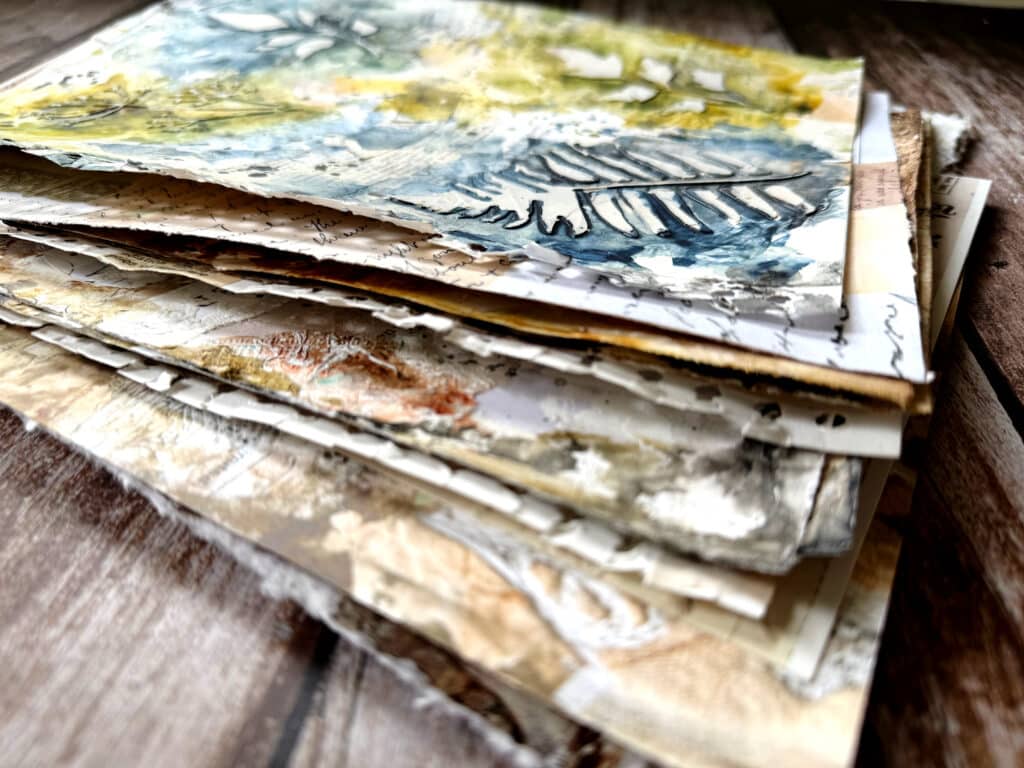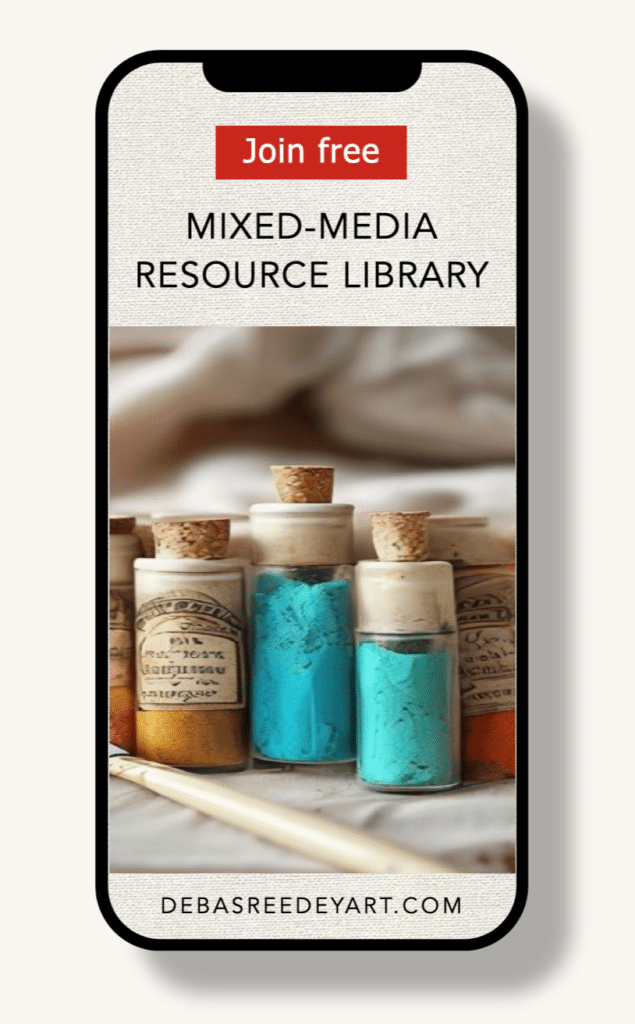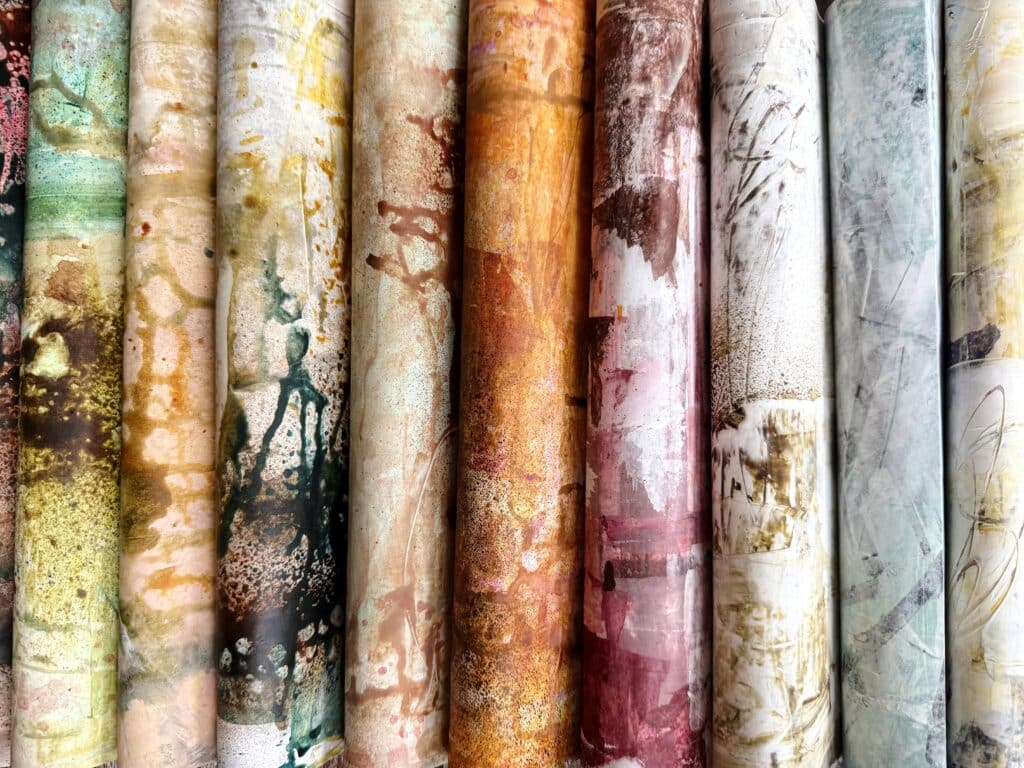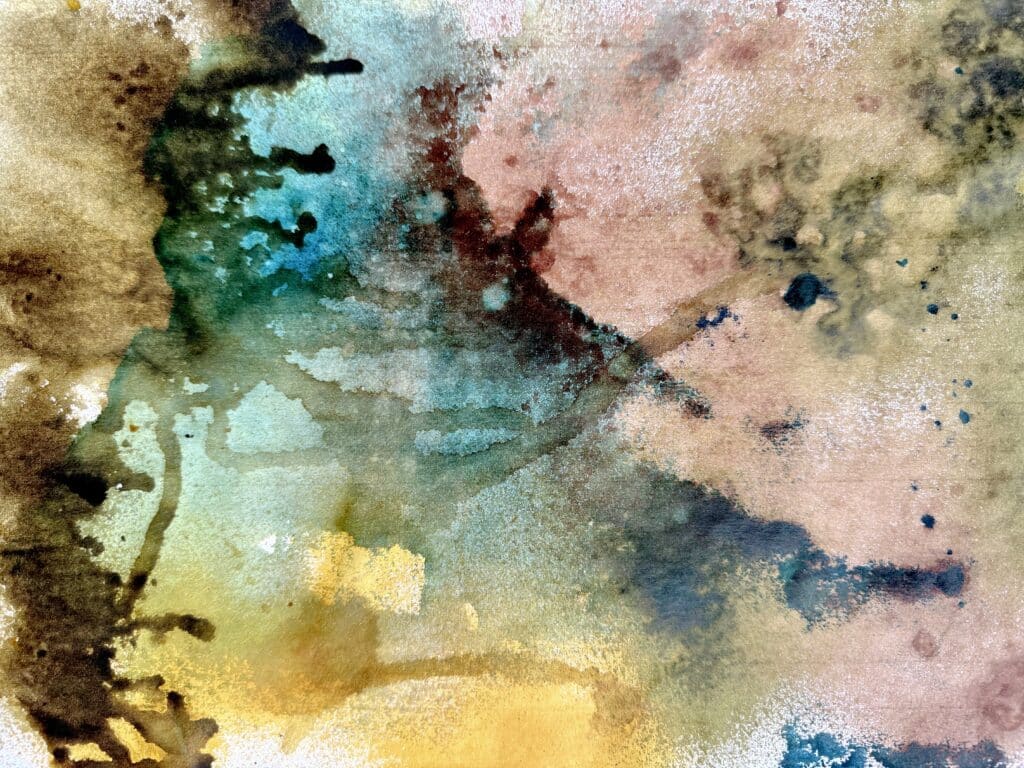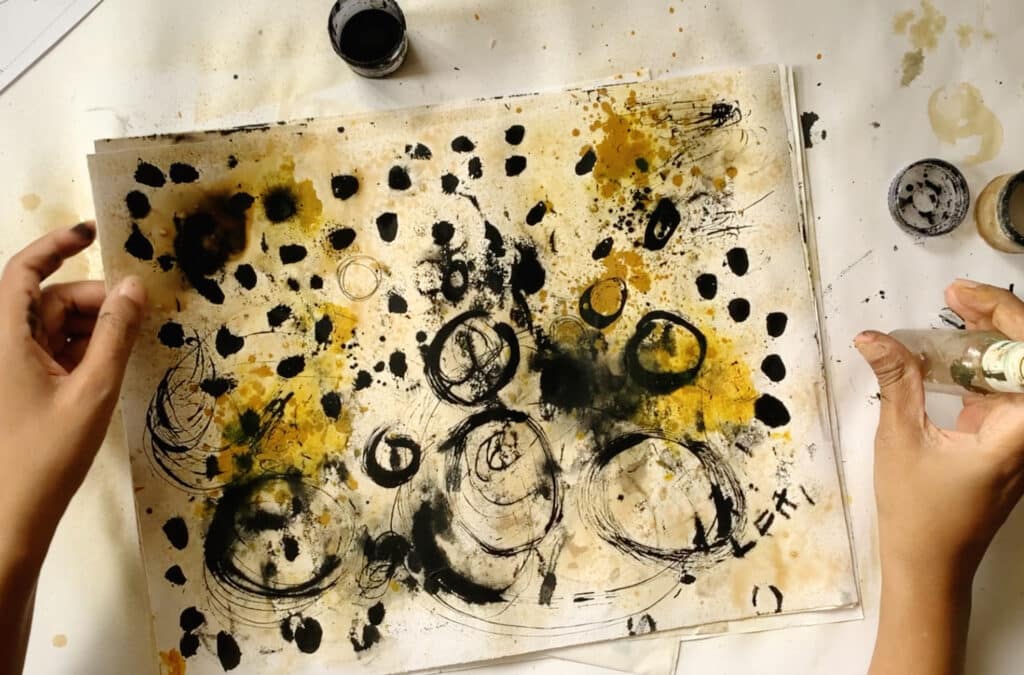A poetic guide to layering scraps, emotion, and texture into collage-ready backgrounds
Do you have a growing pile of torn book pages, lace edges, vintage papers, and tissue bits that you can’t throw away—but you’re not sure what to do with them either?
You’re not alone. These fragments—often dismissed as “leftovers”—carry history, texture, and story. And when layered thoughtfully, they become the soulful base for rich, expressive art.
In this guide, I’ll walk you through how I create MasterSheets from those very fragments—whether for art journaling, clusters, postcards, or collage work. I’ll share the exact methods I use, plus some beautiful combinations you can try yourself.
🧩 What is a MasterSheet?
A MasterSheet is a large, layered collage base made from fragments of paper and fabric. It can be used as is, or cut down into smaller pieces like:
Tags
Postcards
Mini artwork
Journal pages
Collage fodder
Think of it as a visual playground—a way to gather, unify, and transform all your fragments into something meaningful.
📊 Mastersheet Creation Formula Chart
(Fragments → Blending → Texture → Finishing Touches)
Fragments (Glue with gel medium) | Blending Layer (After gluing) | Add Texture | Finishing Touch |
Book pages & ephemera | Gesso (thick/thin) + fingers | Wrinkled tissue | Watercolor splatter |
Colored scraps / collage offcuts | Gesso (thick/thin) + knife | Masking tape | Acrylic ink drips |
Printed or handwritten text | Gesso (thick/thin) + brush | Doilies | India ink + water |
Fabric offcuts | Unbleached titanium acrylic | Dyed gauze/lace/net | Handwritten scribble |
Brown tissue or teabag papers | Soft pastel colors + brush | Modeling paste | Script stamping |
Black & white paper | Coffee/tea stain wash | Corrugated paper | Focal point cluster |
Cardboard or brown bag fragments | Dry brushing with neutral paint | Paper stencils | Edge darkening |
Sketchbook spine with holes | Acrylic glaze | Clusters | Metallic shimmer |
💡 Combine freely—some MasterSheets are simple; others layered and rich.
💡 Try This:
What happens when you combine black & white scraps + brown teabag paper + thick gesso + blue watercolor drips?
What if you use only translucent layers over text and blend with white gesso for a dreamy effect?
📖 The Four Layers of a MasterSheet
Every MasterSheet is built using a simple layering structure:
1🪶 1. Fragments (Foundation layer with scraps)
The heart of the page. These are your torn, textured, and tinted pieces. Choose any combination of these to start your MasterSheet.
Fragments of torn book pages
Printed or handwritten ephemera
Used teabag papers
White & brown tissue
Brown paper bags
Colored paper leftovers
Tissue paper with marks or stamping
Sketchbook spine strips or hole-punched margins
- Offcuts of master sheets or collage leftovers
→ Adhere with: Gel medium or liquid glue
🎨 2. Blending Layer (Softening & Unifying the Surface)
This softens harsh edges and pulls all the fragments into one visual story.
Gesso (finger, brush, or knife)
Soft pastel paint (e.g. pale pink, ochre, sage)
Coffee/tea staining
Acrylic glaze
Dry brushing with neutral paints (unbleached titanium, pale ochre)
💡 Optional: Let some fragments peek through and some disappear.
🧵 3. Texture Layer (Dimension & Tactility)
This is where your page becomes touchable. It adds dimension and surprise.
Wrinkled tissue (over fragments)
Masking tape (flat or wrinkled)
Modeling paste through stencils (florals, script, botanicals)
Paper doilies or lace pressed into wet medium
Scratched marks into wet gesso
Teabag edges or netting glued down with gel medium
💡 Don’t aim for perfection—irregularity adds beauty.
🖋️ 4. Finishing Touch (Energy & Expression))
This is the final energy—where you add mood, voice, and clarity.
Watercolor washes or splatters
Acrylic ink or India ink drips
Scribbles with pencil or pen
Script stamping or handwritten text
Gold foil, mica powder, or metallic paint
Focal point collage (clustered or centered)
Edges darkened with charcoal or ink
Focal points: butterflies, portraits, botanicals
Sentiment strips or words
🖼️ Sample MasterSheet Recipes to Try
🌿 Dreamy Vintage
A soft, romantic blend of tissue and timeworn paper
Fragments: Torn book pages, ephemera, white and brown tissue, used teabag paper, paper doilies
Blend: Gesso applied with a palette knife to unify and soften
Texture: Wrinkled translucent layers create natural folds and creases
Finishing Touches: Watercolor washes, splatter + faded script stamp
Mood: Worn, delicate, and timeless—like a letter found in an old attic
☕ Earthy & Grungy
A richly textured page with deep tones and tactile surprises
Fragments: Wrinkled masking tape, brown paper bag, sketchbook spine strips with punched holes
Blend: Thick gesso brushed over the surface, then scratched with tools
Texture: Holes, creases, and ridges from spine pieces and marks
Finishing Touches: Dripped acrylic inks and black India ink, activated with coffee solution and water spray
Mood: Wild, organic, and grounded—like decaying leaves under forest rain
🌸 Soft & Romantic
A pastel dance of lace, texture, and florals
Fragments: Colored collage bits, delicate lace or doilies, masking tape
Blend: Soft pastel colors brushed gently with gesso to blend
Texture: Modeling paste through floral stencils on top of the blended background
Finishing Touches: Watercolors and acrylic ink painted carefully around the raised stencils
Mood: Feminine, floral, and dreamy—like pressed petals in a handmade diary
📜 4. Text & Texture
A cluttered bookish background made entirely of paper fragments
Fragments: A dense mix of small torn book text, vintage paper, and ephemera
Blend: None or very minimal blending to keep the rawness visible
Texture: Created entirely through visual layering and paper scale (small = dense texture)
Finishing Touches: Optional focal clusters or pockets can be added later
Mood: Bold, chaotic, literary—like thoughts scribbled on overlapping pages
🧵 5. Clean & Vintage
A simpler collage with larger fragments and soft neutral tones
Fragments: Larger torn ephemera, vintage ledger or neutral-toned paper
Blend: Soft dry brushing or minimal gesso to preserve clarity
Texture: Light layering with fabrics or semi-translucent tissue
Finishing Touches: Hand-drawn lines or one soft focal image
Mood: Calm, minimal, archival—like a preserved field journal or memory book
🖋️ 6. Botanical Script
A textured pastel background layered with soft stencils and floral echoes
Fragments: Torn papers with writing or soft color tones, masking tape
Blend: Soft gesso + pastel color blending with a brush
Texture: Modeling paste through botanical stencils (flowers, leaves, flourishes)
Finishing Touches: Watercolor washes + carefully brushed acrylic ink to highlight stencil edges
Mood: Gentle, hopeful, blooming—like spring emerging through an old letter
Mixed Media Artist Resource Library
Free printables, collage papers, creative prompts & how-to guides
I’ve put together a free resource library designed just for you, packed with everything you need to fuel your creativity. It’s my way of giving back to the mixed media community with resources to inspire your next project. Click here to join.
🌈 Color Changes Everything
Let your fragments speak through color—every palette tells a new story.
While the structure and layering of a MasterSheet may follow the same process, your color choices shift the entire emotional feel of the piece. Whether you’re working with muted tones, vibrant hues, or monochrome shades, color becomes the mood-setter of your journal.
Even using the same materials—book pages, tissue, masking tape—your page could feel soft and dreamy or grungy and bold, romantic or wild, depending entirely on the colors you layer in.
Before you begin your MasterSheet, ask yourself:
What do I want this page to feel like?
Let your color palette answer for you.
🎨 Color Mood Board
| Mood/Theme | Color Palette | Emotional Feel |
|---|---|---|
| Earthy + Grounded | Ochre, raw umber, burnt sienna, coffee-stain brown | Rooted, warm, nostalgic |
| Dreamy + Romantic | Blush pink, lavender, soft beige, dusty rose | Tender, light, poetic |
| Neutral + Wabi-Sabi | White, cream, grey, parchment, pale brown | Minimal, quiet, weathered |
| Grungy + Moody | Black, charcoal, indigo, rust, deep brown | Raw, messy, expressive |
| Soft + Reflective | Sage green, dusty blue, warm grey, faded teal | Calming, thoughtful, meditative |
| Bold + Expressive | Crimson, mustard, turquoise, magenta | Energetic, rebellious, playful |
| Vintage Monochrome | Black, white, tan, sepia tones | Classic, elegant, archival |
💡 Tip: Start with your existing fragments—what colors do they lean toward? Let that guide your palette, or pick a mood first and choose fragments to match.
🎨 Color Combo Prompts Based on Emotional Themes
Use these if you want your MasterSheet to hold a specific emotional intention or vibe.
🕊 Quiet Nostalgia
Soft cream, faded typewritten brown, transparent white tissue, pale rose
Use: Light gesso, wrinkled tea paper, script stamps
🔥 Fierce Intuition
Crimson, charcoal black, coffee brown, burnt orange
Use: Strong ink splatters, bold script, scratch marks
🍃 Gentle Renewal
Sage green, warm grey, off-white, recycled textures
Use: Modeling paste stenciled leaves, translucent gauze, subtle color wash
🩶 Tender Grief
Dusty blue, soft grey, vintage book pages, watery lavender
Use: Tear marks, minimal collage, faint words, open space
🖤 Elegant Decay
Black and white with parchment, sepia, and metallic gold touches
Use: India ink, lace, embossed textures, distressed edges
🦋 Liberated Joy
Turquoise, magenta, mustard yellow, collage bits from playful papers
Use: Scribbles, bursts of color, layered clusters with movement
✍️ Frequently Asked Questions (FAQ)
🟤 Do I need specific scraps or fragments to create these MasterSheets?
Not at all. You can use whatever you have on hand—old book pages, ephemera, painted papers, tissue, fabric bits, coffee-dyed paper, packaging, or even brown paper bags. The beauty lies in transforming what feels forgotten or “leftover” into something beautiful and meaningful.
🎨 What kind of paint or color medium should I use?
You can use a mix:
Watercolors for soft blending
Acrylic inks for bold effects and drips
Acrylic paint for layering and dry brushing
Pastels for gentle blending and a matte, vintage look
Choose based on your desired mood and texture.
🧴 What adhesive is best for gluing the fragments?
A soft gel medium or matte gel medium works best for gluing paper and light fabric. It dries flat and transparent, and it allows you to layer and seal at the same time. You can also use any good-quality craft glue, but avoid watery glues that wrinkle thin papers.
🧶 Can I use fabric fragments too?
Yes, definitely! Light, soft fabrics like gauze, lace, net, and cheesecloth layer beautifully with paper. They add texture and a soft tactile element. Use them sparingly or build them up depending on your composition.
📐 How big should my MasterSheets be?
You can start with A3 or A4 size papers—whatever you have available. Later, these can be cut into smaller A6 pages, postcards, tags, or collage elements. If you’re new to this, A4 is easier to handle and less overwhelming.
🖼️ What if I don’t like how it looks halfway through?
That’s completely normal. Most MasterSheets go through an “ugly” or messy middle stage. Keep going. Layer more. Blend a bit. Add a translucent material. Often, that’s where the beauty emerges.
📚 What can I do with the finished MasterSheets?
So many things! You can:
Use them as art journal backgrounds
Cut them into tags, pockets, or postcards
Add focal images and turn them into small standalone artworks
Bind them into a fold-out journal or zine
Scan and print them as collage sheets or digital printables
They’re incredibly versatile and reusable.
🧵 Can I make themed MasterSheets based on color?
Absolutely. That’s one of the most exciting parts. Sort your fragments by color (pinks, neutrals, greens, black-and-white, etc.), and create a whole series of color-themed sheets. Each one will hold a different energy and visual story.
💭 Final Thoughts
Your scraps, your fragments, your leftovers—they hold stories. They hold time.
Creating MasterSheets is not just about technique—it’s a gentle practice of gathering what’s been forgotten, layering with intention, and letting color breathe new life into paper and memory. Each sheet you make becomes a quiet reflection of your inner landscape—soft, bold, moody, playful—whatever you need it to be.
You don’t need perfect materials. You just need curiosity and a willingness to explore.
So go ahead—gather your fragments. Let them speak. Let them become.
“What you call scraps, the soul calls offerings.”

